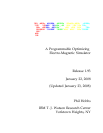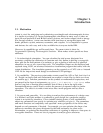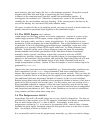Of course, there is one very good reason why such a capability has not been available
before: it can be quite slow. One simulation can take minutes or hours to run, so an
optimization requiring many runs may take quite a while. While this is still a cogent
objection in many cases, POEMS’ ability to scale to large clusters can make this pretty
snappy. Even without a cluster, the continued improvements in personal computer CPU
speed and memory size allow nontrivial multi-parameter optimizations to be run on a
laptop in a few hours, with little or no supervision. Given the economic importance of
many of these devices, e.g phase shift masks and optical waveguide devices, there is now
a large class of problems for which an optimizing FDTD simulator is a useful tool. This
is particularly true when the simulator can run seamlessly on one machine or a large
cluster of machines of different types and architectures, as POEMS can.
Furthermore, the same techniques designers use to guide existing simulators, e.g. physical
and analytical models, can be used with POEMS, with an order-of-magnitude decrease in
the amount of time spent baby-sitting the simulator.
The current release of POEMS, V 1.63, does almost all of these things already, and more
are under development.
1.1.1. Philosophy
The idea of POEMS is to keep the design problem in view, and to make the program fade
into the background. This doesn’t need fancy user interfaces so much as freedom from
limitations and constant manual-reading. This philosophy drove the design, leading to
these goals:
Clarity:
-Accept human-readable input with no unnecessary parameter order
dependencies;
-Use mnemonic names;
-Provide accurate and specific error messages
-Understand optical terms, e.g. amplitude and phase, aberration coefficients,
power dissipation, efficiency, mode matching with commonly used pupil
functions e.g. Gaussian and Airy (uniform pupil);
-Provide high-level geometric constructs, e.g. gratings and smooth curved
tapers and bends;
-Specify dimensions the way you’d measure with calipers—round correctly
and avoid worries about counting from 0 or from 1;
-Automate fiddly things that go wrong easily, e.g. configuring the perfectly-
matched layer (PML) absorption directions or figuring out n and k for a
normal conductor
Power:
-Use the best existing open-source software, e.g. FFTW and VIS5D
-Work on many platforms, at least Linux, OS/2, and Windows (The author is
an OS/2 diehard but recognizes the quixotic character of this)
-Provide advanced visualization tools: bitmaps, animations, and (especially) 3-
2


















